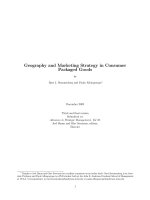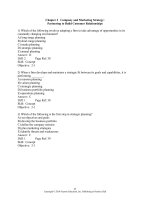Consumer behavior and marketing strategy 12e hawkins motherbaugh chapter 08
Bạn đang xem bản rút gọn của tài liệu. Xem và tải ngay bản đầy đủ của tài liệu tại đây (1.47 MB, 33 trang )
CHAPTER
08
Perception
McGraw-Hill/Irwin
Copyright © 2013 by The McGraw-Hill Companies, Inc. All rights reserved.
8-2
Learning Objectives
Describe the nature of perception and its relationship
to consumer memory and decisions
Explain exposure, the types of exposure, and the
resulting marketing implications
Explain attention, the factors that affect it, and the
resulting marketing implications
Explain interpretation, the factors that affect it, and the
resulting marketing implications
Discuss how perception can enhance strategies for
retailing, branding, advertising, and packaging
8-3
Consumer Behavior In The News…
Now THAT’S Heavy!
Can you guess which part of a product package
is perceived as suggesting “heavier” versus
“lighter”?
First – Bottom versus Top?
Second – Left versus Right?
Source: X. Deng and B. Kahn, “Is Your Product on the Right Side?” Journal of Marketing Research, December 2009, 725-738.
8-4
Consumer Behavior In The News…
Now THAT’S Heavy!
Can you guess which part of a product package
is perceived as suggesting “heavier” versus
“lighter”?
Bottom-right – is correct…these are considered
“heavy” locations…
Implication - when weight is positive (cookies = more
is better), putting a product picture in heavy package
locations creates highest attitude.
Source: X. Deng and B. Kahn, “Is Your Product on the Right Side?” Journal of Marketing Research, December 2009, 725-738.
8-5
The Nature of Perception
8-6
Exposure
Types of Exposure
1. Selective Exposure
•
The highly selective nature of consumer exposure is a
major concern for marketers, since failure to gain
exposure results in lost communication and sales
opportunities.
2. Voluntary Exposure
•
Although consumers often avoid commercials and other
marketing stimuli, sometimes they actively seek them
out for various reasons including purchase goals,
entertainment, and information.
8-7
Exposure
Selective Exposure and DVRs
DVRs in 40% of U.S. Households
DVR may increase ad avoidance although evidence
is mixed
Strategies to adapt in a DVR world
Ad compression
Still-frame ads
Hybrid ads
Interactive ads
Dynamic ad placement
8-8
Attention
Attention is determined by three factors:
1. Stimulus Factors
•
Are physical characteristics of the stimulus itself
2. Individual Factors
•
Are characteristics which distinguish one individual from
another
3. Situational Factors
•
Include stimuli in the environment other than the focal
stimulus and temporary characteristics of the individual
that are induced by the environment
8-9
Attention
Stimulus Factors
Size
Intensity
Attractive Visuals
Color and Movement
Position
Isolation
Format
Contrast and Expectations
Interestingness
Information Quantity
8-10
Attention
Stimulus Factors: A Closer Look
Color and Movement
Color and movement attract
attention.
Color and Size Impact on
Attention1
A brightly colored package
or display is more likely to
received attention.
Color and movement are
also important in ads.
Source: 1”How Important is Color to an Ad?” Starch Tested Copy. February 1989,
p.1. Roper Starch Worldwide, Inc.
8-11
Attention
Stimulus Factors: A Closer Look
Position
Position is the placement of an
object in physical space or
time.
In retail stores, items that are
easy to find or stand out are
more likely to attract attention,
such as end-caps and kiosks.
High impact zones in print ads
in the U.S. tend to be toward
the top left portion of the ad.
End-caps provide a way to
capture the shopper’s attention
8-12
Attention
Stimulus Factors: A Closer Look
Contrast and Expectations
Consumers pay more attention to
stimuli that contrast with their
background.
Expectations drive perceptions of
contrast. Ads that differ from
expectations for a product category
often motivate more attention.
Adaptation level theory suggests
that if a stimulus doesn’t change
over time we habituate to it and
begin to notice it less.
This billboard ad provides
contrast for enhanced attention.
8-13
Attention
Individual Factors
Motivation
Ability
8-14
Attention
Situational Factors
Clutter
Program Involvement
8-15
Attention
Situational Factors: A Closer Look
Program Involvement
Program involvement
refers to interest in the
program or editorial
content surrounding the
ads.
Program involvement has
a positive influence on
attention (see graph).
Source: 1”Cahners Advertising Research Report 120.1 and 120.12 (Boston: Cahners Publishing, undated).
8-16
Attention
Nonfocused Attention
Hemispheric lateralization
Subliminal Stimuli
8-17
Attention
Nonfocused Attention
Hemispheric Lateralization refers to activities that take place on
each side of the brain.
The left side of the
brain controls
activities related to
rational thought.
The right side
of the brain
deals with
images and
impressions.
8-18
Attention
Nonfocused Attention
Subliminal Stimuli
A message presented so fast, softly or masked by other messages
that one is not aware of seeing or hearing it is call a subliminal
stimulus.
stimulus
A subliminal ad “hides” key persuasive information within the ad by
making it so weak that it is difficult or impossible for someone to
physically detect.
Subliminal advertising has been the focus of intense study and
public concern.
8-19
Interpretation
Three aspects of interpretation:
interpretation
1. It is generally a relative process rather than absolute,
referred to as perceptual relativity.
relativity
2. It tends to be subjective and open to a host of psychological
biases.
3. It can be a cognitive “thinking” process or an affective
“emotional” process.
8-20
Interpretation
•
Cognitive interpretation is a process whereby stimuli
are placed into existing categories of meaning.
•
Affective interpretation is the emotional or feeling
response triggered by a stimulus such as an ad.
Jack Link’s Uses Affective Interpretation
YouTube Spotlight
8-21
Interpretation
Interpretation is determined by three Characteristics :
1. Individual Characteristics
2. Situational Characteristics
3. Stimulus Characteristics
8-22
Interpretation
Individual Characteristics
Traits
Learning and Knowledge
Expectations
8-23
Interpretation
Individual Characteristics
8-24
Interpretation
Individual Characteristics
Learning and Knowledge
The meanings attached to
such “natural” things as time,
space, relationships, and
colors are learned and vary
widely across cultures.
Consumers also learn about
marketer-created stimuli like
brands and promotions
through their experiences
with them.
Color is used in the Wrigley’s ad
to mean “icy and cool.”
8-25









